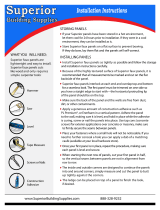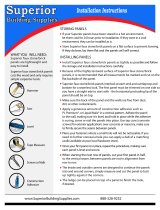
Antico Elements
Architectural Products
Telephone: 305-602-0300
Antico Elements' brick panels are designed to interlock on all sides to create a seamless
look. They are designed for Indoor and Outdoor uses. Even though the installation is very
simple, make sure to read the instructions in order to avoid problems and gaps with these
types of faux brick panels.
Installation Instructions for Antico Elements Brick Panels
Before installations:
Always try to keep the panels leveled. The walls should be dry and free of dust. We strongly suggest the use of the fasteners
and plenty of adhesive where the panels and lips overlap.
Important: When using the product outdoor make sure to store the panels in a cool area before installing them. If they are left
in a hot place it may cause a small degree of shrinkage when the outside temperature drops.
• Measuring tape and pencil
• Table saw, circular saw, miter saw, jig saw etc. You can use any blade designed for wood. Our material is very friendly.
• Nails or screws (exterior grade if used outdoor and masonry screws for brick, concrete etc.)
• Nail set
• Hammer (or screw driver/drill if using screws)
• Level
• Framing square
• Chalk line
• Construction adhesive, E.G: Liquid Nails, PL, etc.
• Safety Glasses
Tools needed: ( same as wood cutting tools )
Our products can be installed directly over framing, drywall, brick or concrete.
-For indoor all you need is adhesive, caulking and wood screws or long staples/finish nails.
-For outdoor you might need an exterior grade adhesive and galvanized screws. Some caulking may be needed.
-For brick, concrete, cinder blocks and similar you will need masonry screws, such as "Tapcons".
Installing Panels
It is always a good idea to temporarily lay out the faux brick panels around the project to plan which / how faux brick panels
will be cut and which will not.
We recommend that you install the panels from right to left
For better results marks some horizontal chalk lines on the wall to keep your panels leveled.
Position the panels so that the horizontal lip is at the top and the horizontal notch at the bottom.
If the first panel butts against anther wall, the right side of the first panel should be trimmed, removing the protruding fingers
and creating a straight edge.
Please see the two images below:
ANTICO ELEMENTS - Headquarters: 3520 NW 46Th Street Unit #4 33142 Miami, Florida United States
Antico Elements
Architectural Products
Telephone: 305-602-0300
Antico Elements' brick panels are designed to interlock on all sides to create a seamless
look. They are designed for Indoor and Outdoor uses. Even though the installation is very
simple, make sure to read the instructions in order to avoid problems and gaps with these
types of faux brick panels.
ANTICO ELEMENTS - Headquarters: 3520 NW 46Th Street Unit #4 33142 Miami, Florida United States








